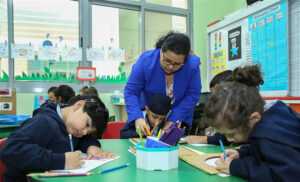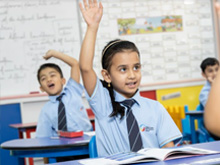Dubai has long been regarded as a global leader in advanced technology and synthetic beauty. It goes by many names in the world, spanning fashion to education.
A large population of Indians live here permanently, and they are concerned about their children’s educational needs.
As a result, they are looking for a CBSE curriculum in Dubai Schools. It can be tough for an Indian youngster to be adopted into another country’s educational system. As a result, their development is not spontaneous.
However, a CBSE curriculum school in Dubai provides them with a welcoming environment in which to receive their education.
The ever-challenging combination of Indian and native educational boards will undoubtedly be a life-changing event for the individual.
The central board of secondary education (CBSE) is a globally standardized curriculum that is taught in more than 24 nations. In 2018, the board had 17,900 schools connected with it. The majority of these, 17,093, are in India, with the remainder scattered across the globe.
In 2016, a total of 1,040,515 candidates enrolled for the class XII test, representing an increase of 1.1 per cent over 2015.
The CBSE takes a more scientific approach to education, with each syllabus separated into segments that are taught throughout the year.
This method enables children to balance the various aspects of their studies. Academically, it is thought to be extremely difficult, with a large set of details that must be memorized.
However, some have recently criticized the lengthy curriculum, claiming that it has remained stagnant and has failed to educate today’s youth for the demands of the future workforce.
Many parents have raised concerns that the curriculum has remained mostly unchanged over generations, and that there is little obvious difference between how they learned in school and how their children are learning now.
Many parents criticize the system for its emphasis on rote learning and memorization, as well as its purportedly outdated assessment techniques and a failure to update topics and themes.
Before enrolling one child into an institution with a CBSE curriculum, check out the advantages of choosing the CBSE curriculum for your child:
Advantages of CBSE Curriculum
● A greater number of schools are available.
● The programme meets the requirements of most college entrance examinations.
● Allows candidates from non-affiliated schools and private students to sit for the exams.
● Less emphasis on language and more on math and science.
● Expatriates and NRIs in general who may return to India will benefit greatly from standardized textbooks (NCERT textbooks).
● Those who desire to pursue engineering/medical careers prefer this option.
You must be equipped with the knowledge of what the CBSE curriculum offers to make an informed decision. The syllabus is tightly organized and controlled. It makes use of textbooks that are all the same.
Until the eighth grade, no child can fail a class. (Most college entrance tests in the country follow this syllabus.) In 10th grade, board exams are optional, but in 12th grade, they are required.
Those who frequently travel inside India or even abroad to areas such as the Middle East and need a uniform curriculum prefer this option. Those who wish to go along the typical engineering/medical path prefer it.
The concentration of secondary school curriculum varies by school, however, it is mostly on main learning areas (the actual subjects provided will vary).
● Geography, history, economics, home science, sociology, fine arts, political science, fashion studies, creative writing, translation studies, and related subjects are examples of humanities subjects.
● Biology, Chemistry, Physics, ICT, Information Practices, and Web and Multimedia Studies are all subjects in mathematics science and technology.
● Physical Education and Health Regarding the visual and performing arts, – Dance, Drama, Music, Drawing, Painting, Crafts, and Sculpture are just a few examples.
● Business studies, accounting, entrepreneurship, economics, and other related courses fall under the category of commerce.
Instead of three tests per year (quarterly, half-yearly, and annual), the CBSE system uses Formative Assessments (FA) and a single exam (Summative Assessment) to assess students throughout the year (SA). There are two semesters in the programme.
During the first semester, you will be assessed as follows:
FA1: The formative assessment will consist of three activities, each worth ten points:
● Individual Exertion (Making chart, model, project etc)
● Group Exercise (Skit, Model making, project presentations etc)
● A single exam (Summative Assessment)
FA2: The same as before (Final Weightage: 10 marks).
The CBSE curriculum also focuses on the needs of special children in Dubai, Special Education is required under the CBSE system.
School counselors are referred to children who appear to be having learning challenges in class. After observing the kid, the counselor may suggest the child to a Special Education Teacher.
The 20 & Below special education instructor may conduct remedial classes for those pupils separately.
Exam papers for such children are written with the adaptations and alterations that such a youngster requires in mind.
Some youngsters, for example, know the topic but have difficulties in reading; in this case, the question sheets will be read out to them so that they can respond.
Aims of Dubai Schools through the CBSE Curriculum
1. To imbibe 21st-century learning, literacy and life skills.
2. To promote goal setting and lifelong learning.
3. To achieve cognitive, affective and psychomotor excellence.
4. To enhance self-awareness and explore innate potential.
5. To attain mastery overlaid down competencies.
6. To inculcate values and foster cultural learning and international understanding in an interdependent society.
7. To acquire the ability to utilize technology and information for the betterment of humankind.
8. To strengthen knowledge and attitude related to livelihood skills.
9. To develop the ability to appreciate art and showcase talents.
10. To promote physical fitness, health and well-being.
11. To promote arts-integrated learning.
Students receive a broad and balanced understanding of subjects such as languages, mathematics, science, and social science in the secondary curriculum, enabling them to communicate effectively, analyze information, make informed decisions, construct their worldview in accordance with constitutional values, and progress toward becoming productive citizens.
The development of 21st-century abilities in settings where each student feels independent, safe, and comfortable with their learning is a recent priority of CBSE.
The Board is also working to coordinate the curriculum so that students feel more linked to it and can apply what they’ve learned in real-life situations.
Children must have enough knowledge and abilities in other fundamental areas such as Health and Physical Education, Life Skills, Values Education, Art Education, Work Education, and other Co-Scholastic disciplines in order to reach this goal.
In terms of operation, the secondary curriculum is learner-centered, with the school serving as a venue for pupils to learn a variety of abilities such as self-concept, enterprise, artistic sensibility, and sportsmanship.
As a result, this curriculum incorporates significant learning areas from both a scholastic and non-scholastic perspective in order to build basic competencies in learners.
To come to a conclusive decision on choosing the right CBSE Curriculum school in Dubai, it is important to apply the aforementioned to the process.
































